Teledentistry Market Size and Forecat 2025 to 2034
The global teledentistry market size was calculated at USD 1.75 billion in 2024 and is expected to reach around USD 7.18 billion by 2034. The market is expanding at a solid CAGR of 15.16% over the forecast period 2025 to 2034. The North America teledentistry market size reached USD 550 million in 2023. Teledentistry benefits include reduced fear factors, such as patients experiencing less anxiety because of convenience and reduced need for travel, improved accessibility, such as remote care and communication, making dentistry more accessible, lower costs while still providing quality care, and more precise treatment. These factors help to the growth of the market.
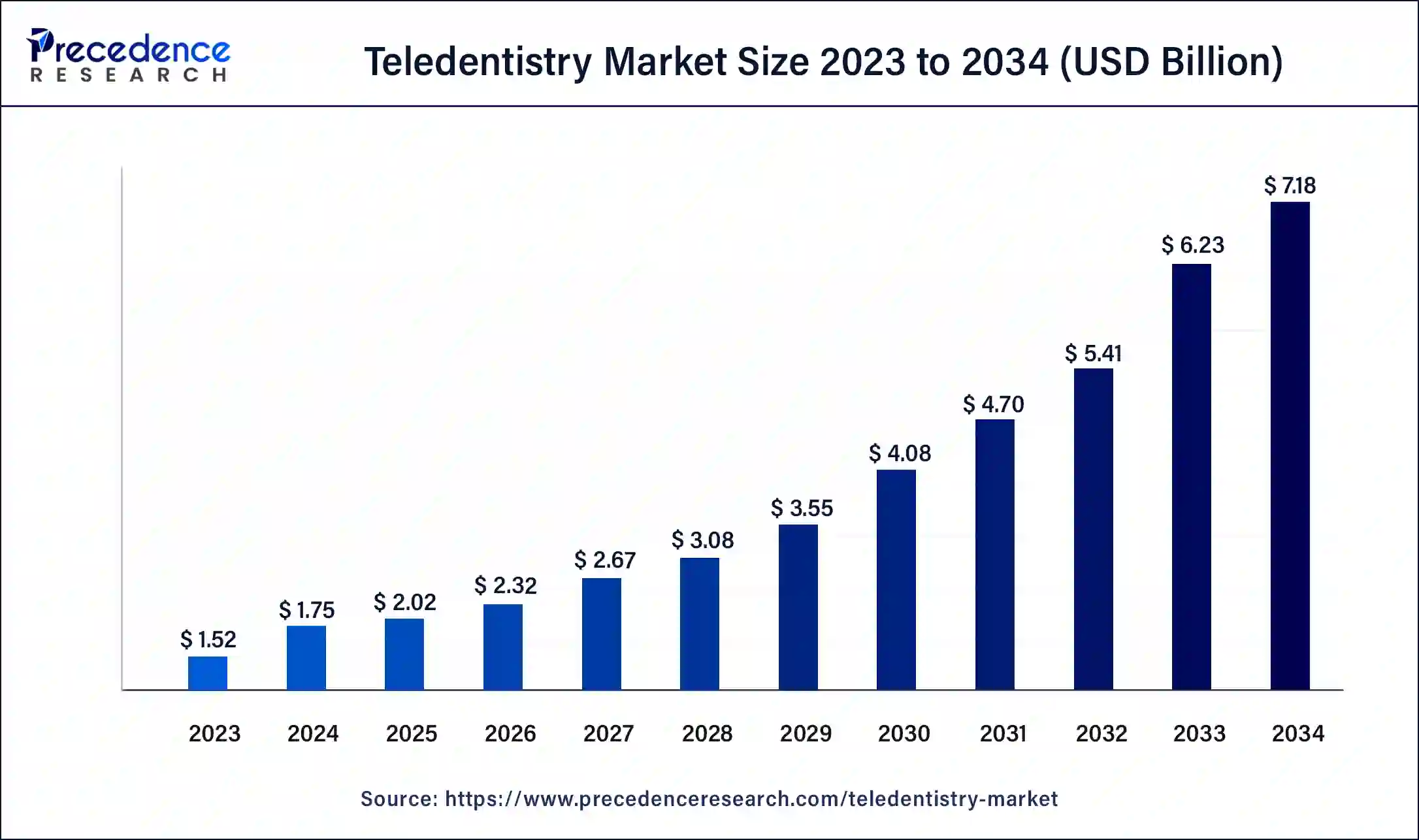
Teledentistry Market Key Takeaways
- The global teledentistry market was valued at USD 1.75 billion in 2024.
- It is projected to reach USD 7.18 billion by 2034.
- The teledentistry market is expected to grow at a CAGR of 15.16% from 2025 to 2034.
- North America dominated the teledentistry market with revenue share of 36% in 2024.
- Asia Pacific is estimated to be the fastest growing during the forecast period of 2025-2034.
- By component, the software segment has accounted revenue share of 74.5% in 2024.
- By component, the hardware segment is anticipated to be the fastest-growing during the forecast period.
- By delivery mode, the cloud-based segment has dominated the teledentistry market around 67% in 2024.
- By delivery mode, the web-based segment is expected to grow significantly during the forecast period.
- By application, the teleconsultation segment has dominated the market with revenue share of 57% in 2024.
- By application, the remote patient monitoring segment is estimated to be the fastest-growing during the forecast period.
- By end-use, the providers segment has accounted revenue share of 46% in 2024.
- By end-use, the patients segment is anticipated to be the fastest-growing during the forecast period.
U.S. Teledentistry Market Size and Growth 2025 to 2034
The U.S. teledentistry market size was exhibited at USD 500 million in 2024 and is projected to be worth around USD 2,080 million by 2034, poised to grow at a CAGR of 15.32% from 2025 to 2034.
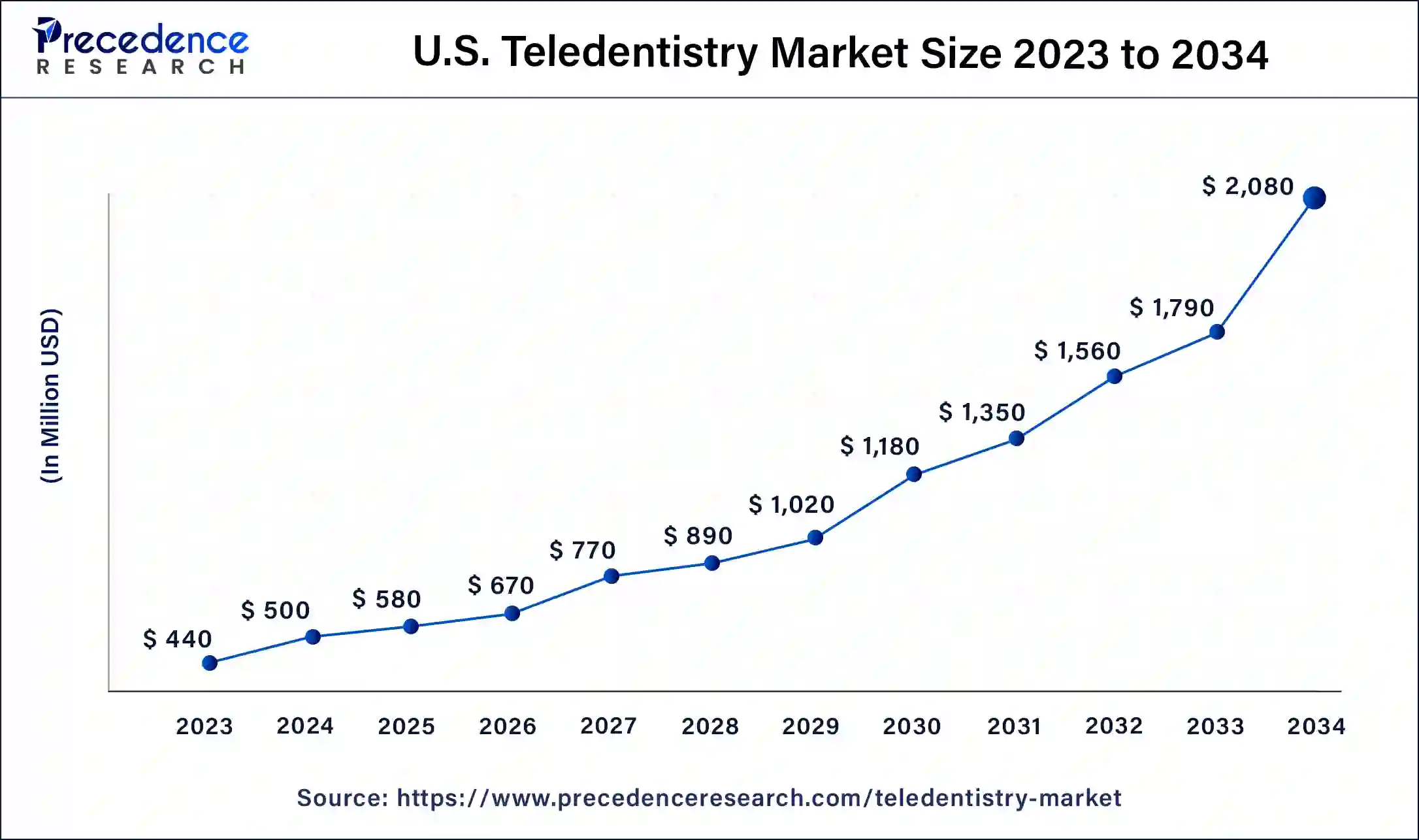
North America dominated the teledentistry market in 2024. The presence of a high number of key players in North America leads to the growth of the market. Increasing awareness related to virtual dental care or teledentistry in public, high use of smartphones, outstanding internet connectivity, and high healthcare IT expenditure can lead to the growth of the market. The constant cloud-based platforms development and their use in developing teledentistry companies contribute to the growth of the market.
- In January 2022, to bring members 24/7 virtual access to dental providers, Sun Life US has collaborated with Teledentistry.com.
- In December 2023, in KANSAS CITY, MISSOURY, USA, to offer access to teledentistry or to expand access to dental care, TeleDentists collaborated with WebMD.
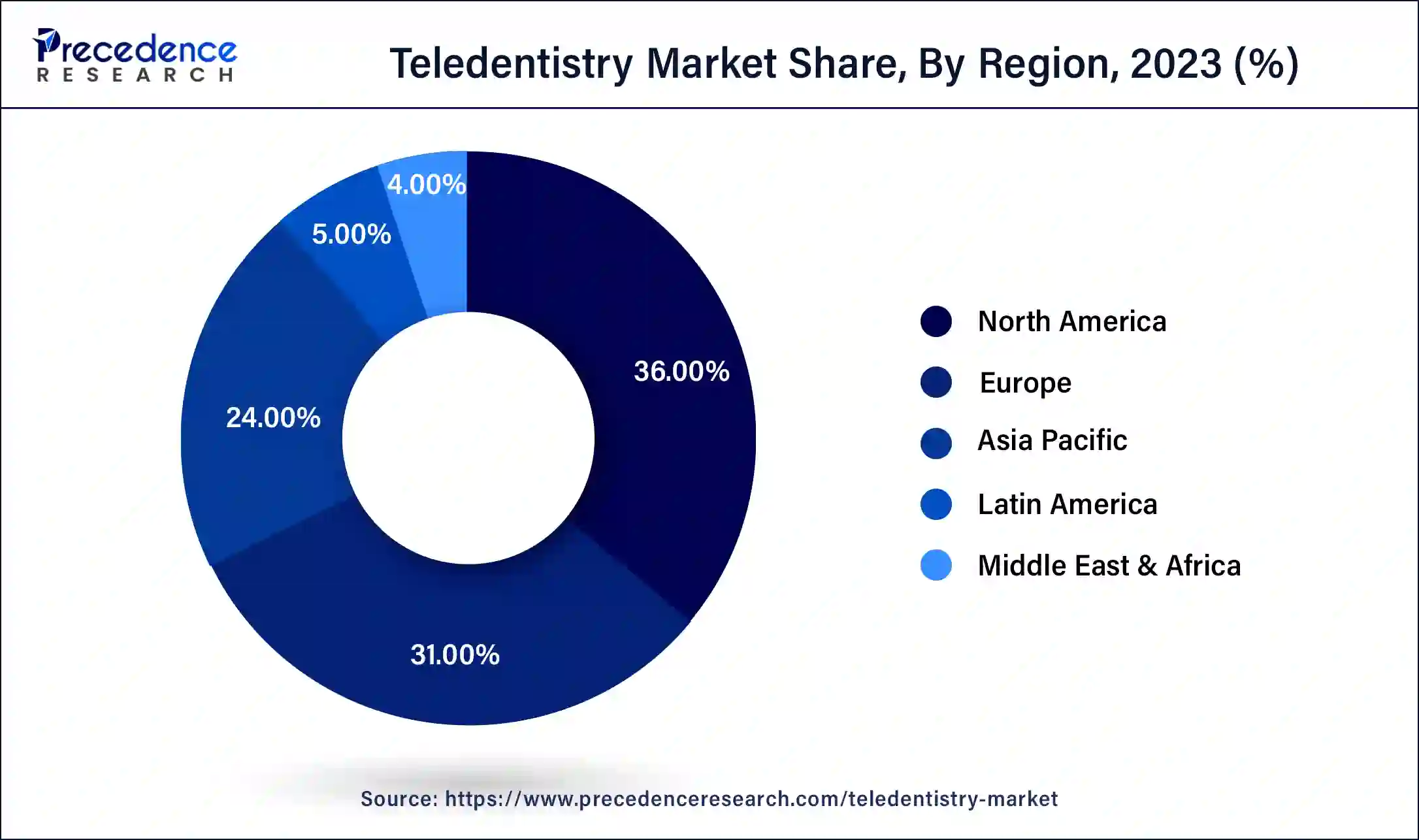
Asia Pacific is estimated to be the fastest-growing during the forecast period of 2025-2034. Increasing investment in countries like Japan, India, China, and Australia can lead to the growth of the market in the Asia Pacific region. Increasing government guidelines and regulations related to teledentistry services can help the growth of the teledentistry market.
Europe is expected to grow significantly in the teledentistry market during the forecast period. The growing aging population in Europe is increasing the demand for teledentistry. It helps in the remote diagnosis and monitoring of patients. The growing innovations and digitalization are also contributing to the same. Moreover, reimbursement policies are provided by the government, which is encouraging their use. Thus, this promotes the market growth.
UK
The growing digitalization is increasing the use of AI in the healthcare sector of the UK. This is increasing the development of teledentistry platforms. Thus, their virtual services are increasing patient compliance and comfort.
Germany
The use of teledentistry in Germany is increasing for post-treatment follow-ups. These services are reducing the number of hospital visits. Furthermore, the presence of policies is increasing the adoption rates.
Market Overview
Teledentistry refers to the use of telecommunications technology to provide dental care and services remotely or the use of telehealth methods and systems in dentistry, including public awareness, education, consultation, and remote care. The teledentistry market deals with providers for the applications of training & education, remote patient monitoring, and teleconsultation. The benefits of teledentistry include reduced fear factor; patients experience less anxiety because of the convenience and reduced necessity for travel. Remote care and communication make dentistry more accessible; teledentistry provides quality care with lower costs and more precise treatment, and dental laboratories and specialists may be reached more easily, enabling accurate diagnosis and individually modified treatment. These factors help to the growth of the market.
Teledentistry Market Growth Factors
- Teledentistry benefits include patients' less anxiety because of its convenience and reduced need for travel, which helps the market grow.
- Remote care and communication make dentistry more accessible; teledentistry provides quality care with lower costs, which helps to the growth of the market.
- It also includes dental laboratories and specialists who may be more easily reached, enabling accurate diagnosis and individually modified treatment.
- The applications of teledentistry include education & training, remote patient monitoring, and teleconsultations, which help grow the teledentistry market.
Teledentistry Market Scope
| Report Coverage | Details |
| Market Size by 2034 | USD 7.18 Billion |
| Market Size in 2025 | USD 2.02 Billion |
| Market Size in 2024 | USD 1.75 Billion |
| Market Growth Rate from 2025 to 2034 | CAGR of 15.16% |
| Largest Market | North America |
| Base Year | 2024 |
| Forecast Period | 2025 to 2034 |
| Segments Covered | Component, Delivery Mode, Application, End-use, and Regions |
| Regions Covered | North America, Europe, Asia-Pacific, Latin America, and Middle East & Africa |
Market Dynamics
Driver
Increasing prevalence of oral disorders
The increasing prevalence of oral diseases can lead to the growth of the market. Oral diseases are caused by a modifiable risk factor range that is common to many NCDs (noncommunicable diseases), including underlying commercial and social determinants, poor hygiene, alcohol use, tobacco use, and sugar consumption. Most of the cases are oral cancers, tooth loss, periodontal diseases, and tooth decay. These factors help to the growth of the teledentistry market.
Restraint
Lack of knowledge
Lack of knowledge related to the reimbursement of teledentistry services policies can hamper the growth of the market. There are also some disadvantages to the growth of the market, which include the necessity for the Internet, health records sharing over the internet may be risky, which leads to privacy concerns, costs for training staff to implement new software technologies in the workplace, and investment in specific software and equipment to provide virtual dental services. These disadvantageous factors can restrict the growth of the teledentistry market.
Opportunity
Advanced technologies
The future opportunities of teledentistry hold huge potential. With the implementation of advanced technologies, we can expect more comprehensive and sophisticated teledentistry services. Machine learning (ML) and artificial intelligence (AI) can play an important role in the evolution of teledentistry. There is an opportunity to overcome disadvantages like privacy concerns, high cost of equipment or software, and internet necessity. These factors help to the growth of the teledentistry market.
Component Insights
The software & services segment dominated the market in 2024. Teledentistry software & services offer many benefits for dental professionals and patients. Teledentistry enables patients to connect with dental professionals virtually, overcoming geographical limitations and improving access to teledentistry services. Modern communication methods in teledentistry provide an appropriate way to interact with dental teams. Equivalent care, effective workflow, and lower costs than traditional methods help the growth of the market. Dental care providers can manage cases, share clinical files, and streamline communication by using a cloud-based teledentistry platform. The benefits of software & services also include free trials, a high adoption rate, guaranteed services, data recovery and backup, amplified security, high compatibility, scalability and accessibility, time management, and cost-effectiveness. These factors help to the growth of the software & services segment and contribute to the teledentistry market.
The hardware segment is anticipated to be the fastest-growing during the forecast period. Teledentistry involves the use of hardware components to provide dental care virtually, and its benefits include allowing secure communication between patients and dentists via mobile or portable devices. It also allows follow-up discussions, appointment scheduling, and real-time consultations without the necessity for in-person visits. Imaging capabilities like the use of portable x-ray devices and intraoral cameras for transmitting and capturing diagnostic images and benefits also include allowing remote assessment of treatment planning, oral health, diagnosis, data exchange, image sharing, and video conferencing. These factors help to the growth of the hardware segment and contribute to the growth of the teledentistry market.
Delivery Mode Insights
The cloud-based segment dominated the teledentistry market in 2024. Cloud-based tools play an important role in teledentistry. The benefits of the cloud-based delivery mode include seamless integration with other systems, improved communication, improved communication, scalability, cost-effectiveness, real-time data and analytics, improved communication and collaboration, processing large volumes of data for research and insights, fast access to platforms and tools for building and testing applications, implementation of machine learning (ML) and artificial intelligence (AI), improved efficiency and performance, and flexibility and reliability. It also includes the benefits of streamlined communication, effective clinical documentation, case management, analytics, and reporting, easier tracking and analysis, secure online storage, no IT permissions needed, and saving time. These factors help the growth of the cloud-based segment and contribute to the growth of the market.
The web-based segment is expected to grow significantly during the forecast period. The web-based delivery mode plays an important role in teledentistry, and its applications are still very popular with the increasing popularity of native mobile apps. The benefits of web-based teledentistry delivery include cost efficiency, design on different devices, consistent performance, accessibility, no installation required, global connectivity, seamless teamwork, increased productivity, flexibility, and accessibility. Mobile applications offer highly advanced functionalities because of the device's hardware and storage access. At the time of the COVID-19 pandemic, real-time video conferencing gained popularity in the teledentistry, with several benefits for patients and dentists. These factors help to the growth of the web-based segment and contribute to the growth of the teledentistry market.
Application Insights
The teleconsultation segment dominated the market in 2024. Teleconsultation plays an important role in teledentistry, and it offers many benefits to patients and dentists. The benefits of teleconsultations include time-saving, teleconsultation with a doctor being more affordable than traditional in-person medical care, allowing many locations throughout the network to take advantage of the expertise and skills found in one part of the healthcare system, and teleconsultations with a doctor being convenient as it may be done from anywhere. It also includes some advantages of virtual consultations, such as cost efficiency, quality treatment, etc. These factors help to the growth of the telecommunication segment and contribute to the growth of the teledentistry market.
The remote patient monitoring segment is estimated to be the fastest-growing during the forecast period. Remote patient monitoring (RPM) plays an important role in teledentistry, which has led to the growth of the market. RPM (Remote patient monitoring) is a technology that permits patients to monitor their health and communicate with their providers from home. RPM can provide benefits for both patients and providers, like improved patient retention, engagement, and satisfaction, increased efficiencies, and lower costs, better treatment adherence and management of health, fewer emergency visits, shorter hospital stays, and reduced hospitalizations. These factors help to the growth of the remote patient monitoring (RPM) and contribute to the growth of the teledentistry market.
End-use Insights
The providers segment dominated the teledentistry market in 2024. To reduce the burden of the disorder in dental facilities, the rate of teledentistry platforms between dental providers should be increased. According to the ADTA (American Tele Dentistry Association), teledentistry benefits include lower costs for patients, improved standards for quality care, and more flexibility for appointments, which increases its use among healthcare providers. Teleconsultations in dentistry provide time savings, may be more affordable than traditional in-person medical care, have accessibility, and are convenient as they can be done from anywhere, which enables their use by healthcare providers. These factors help the growth of the provider's segment and contribute to the growth of the market.
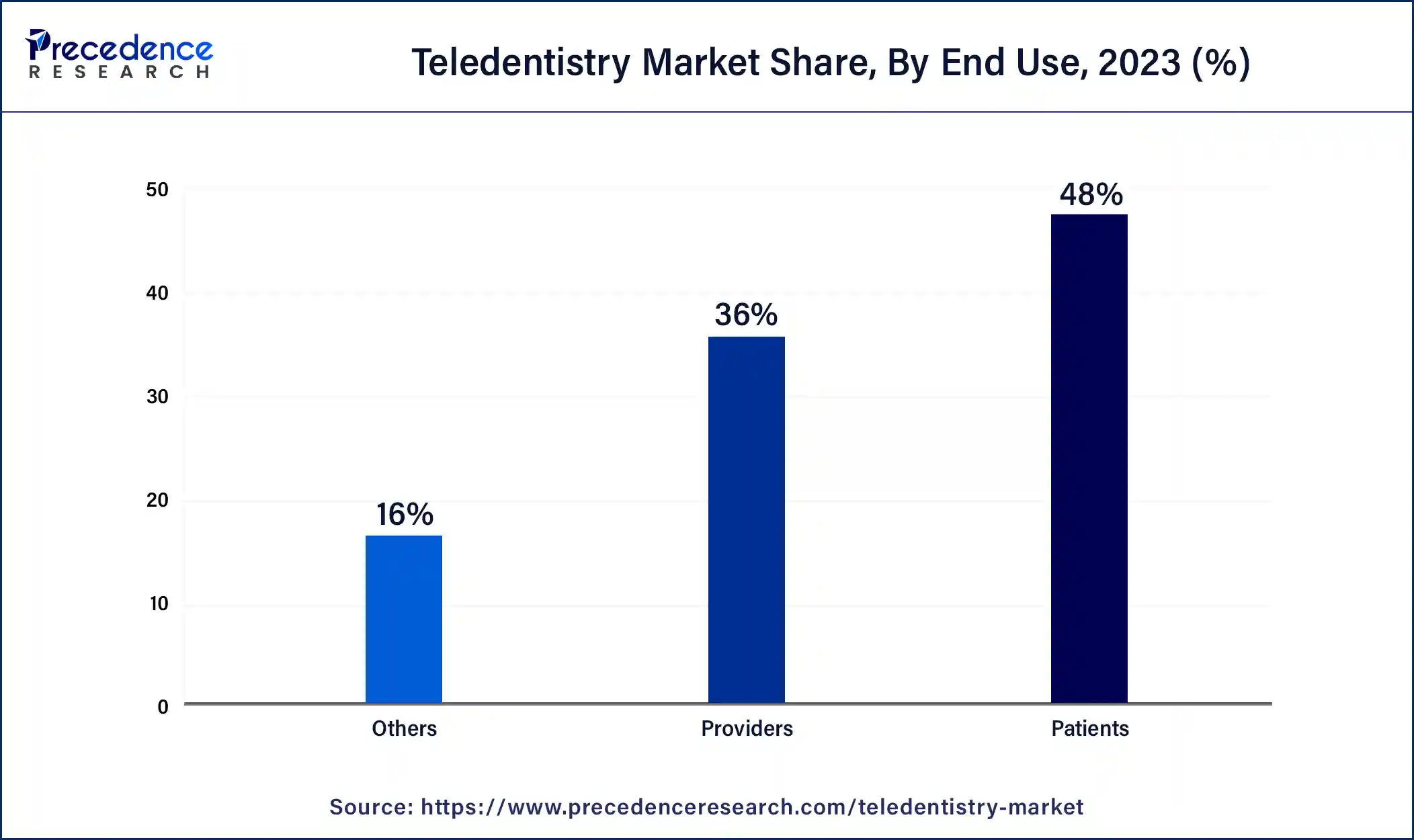
The patient segment is anticipated to be the fastest-growing during the forecast period. Teledentistry offers many benefits for patients, which include reduced risks of respiratory viruses, improved dental hygiene, expanded access for underserved communities, faster response times, and saving money and time by reducing in-person travel and visits. It also includes improved access to dental health, increased flexibility for appointments, less expensive patients, and more precise treatments, allowing for individually tailored treatment and accurate diagnosis. These factors help the growth of the patient segment and contribute to the growth of the teledentistry market.
Teledentistry Market Companies
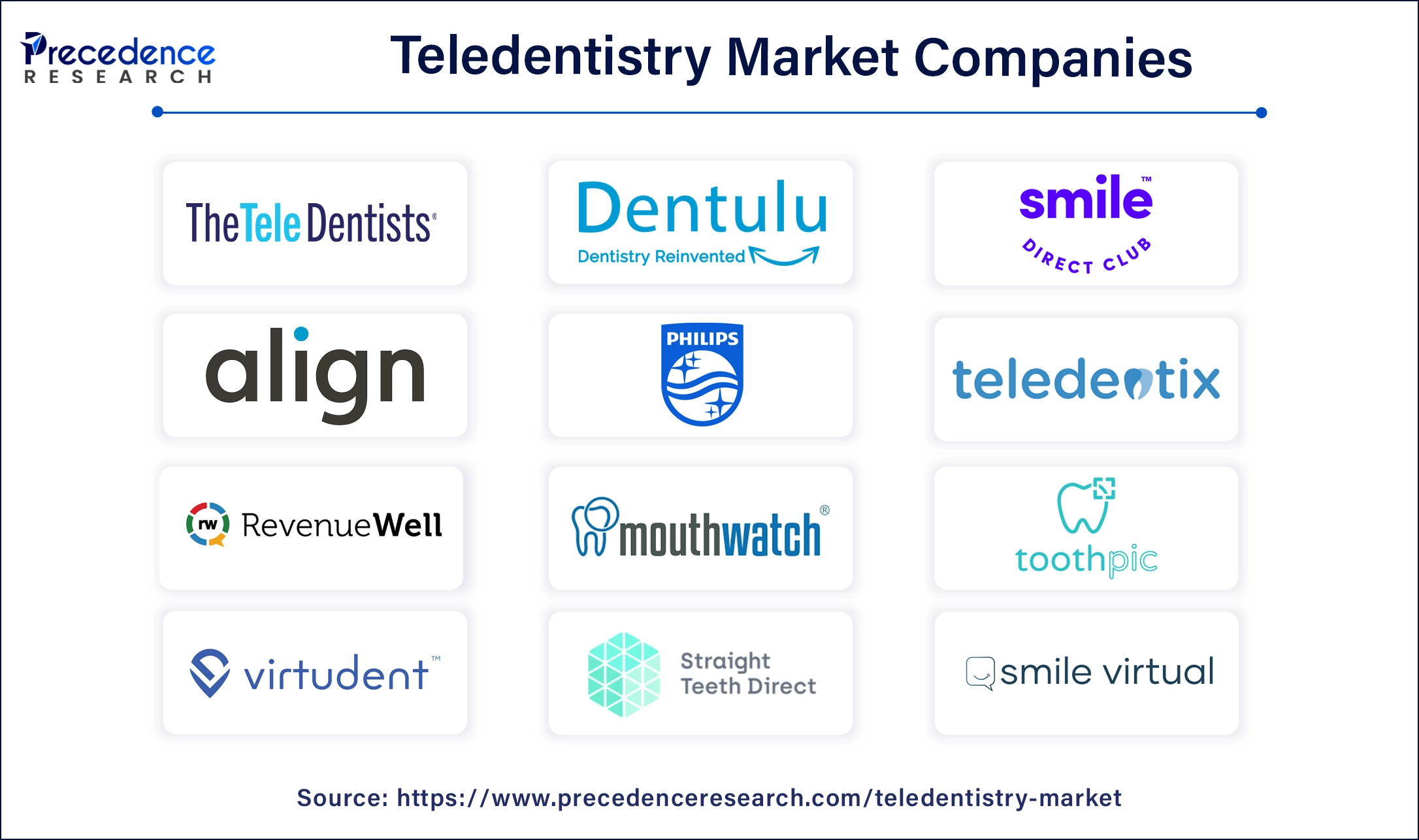
- Straight Teeth Direct
- Virtudent, Inc.
- Smile Virtual LLC.
- Toothpic
- Denteractive Solutions Inc.
- Dentulu, Inc.
- MouthWatch, LLC
- SmileDirectClub
- Align Technology, Inc.
- Koninklijke Philips N.V.
- Candid Care Co.
- The Teledentists
- Teledentix
- Live Dentist
- RevenueWell Systems
- Sesame, Inc.
Recent Developments
- In March 2025, to transform the dental schools' education, merge emerging technologies, and manage clinical operations, a completely managed, cloud-based IT infrastructure solution, that is Cloud Portal, was launched by Hudson Cloud Systems. With the use of this Cloud Portal, the IT backbone of dental institutions will be modernized, where it will provide seamless user experience, tap & go log-in, and on-demand scalability throughout the academic and clinical environments.
- In January 2025, the merging of SOTA Cloud, which is an advanced cloud-based dental imaging platform, with iCoreAcademy, which is a patient education video library, was announced by the leading provider of cloud-based software and technology solutions, that is iCoreConnect Inc. While educating patients on their oral health, the dental professionals can simultaneously review patient X-rays and intraoral images by accessing around 120 iCoreAcademy educational videos of SOTA Cloud through this collaboration.
- In June 2023, Dental.com, the industry's first Teledentistry 3.0, offers increasing personalized care, convenience, and accessibility and provides patients with access to complete dental care from the comfort of their own homes launched by a leading provider of digital dental solutions, Virtual Dental Care.
- In May 2024, for an innovative approach to enhancing access to oral healthcare, a virtual dental care solution, Dentistry. One by MouthWatch was named a 2024 Health Care Hero by NJBIZ. Dentistry. One offers teledentistry services, on-demand virtual dental consultations, and personalized care coordination.
Segments Covered in the Report
By Component
- Software & Services
- Hardware
By Delivery Mode
- Cloud-based
- Web-based
By Application
- Teleconsultation
- Remote Patient Monitoring
- Education & Training
By End-use
- Providers
- Patients
- Others
By Region
- North America
- Asia Pacific
- Europe
- Latin America
- Middle East & Africa
For inquiries regarding discounts, bulk purchases, or customization requests, please contact us at sales@precedenceresearch.com
Frequently Asked Questions
Ask For Sample
No cookie-cutter, only authentic analysis – take the 1st step to become a Precedence Research client
 sales@precedenceresearch.com
sales@precedenceresearch.com
 +1 804-441-9344
+1 804-441-9344